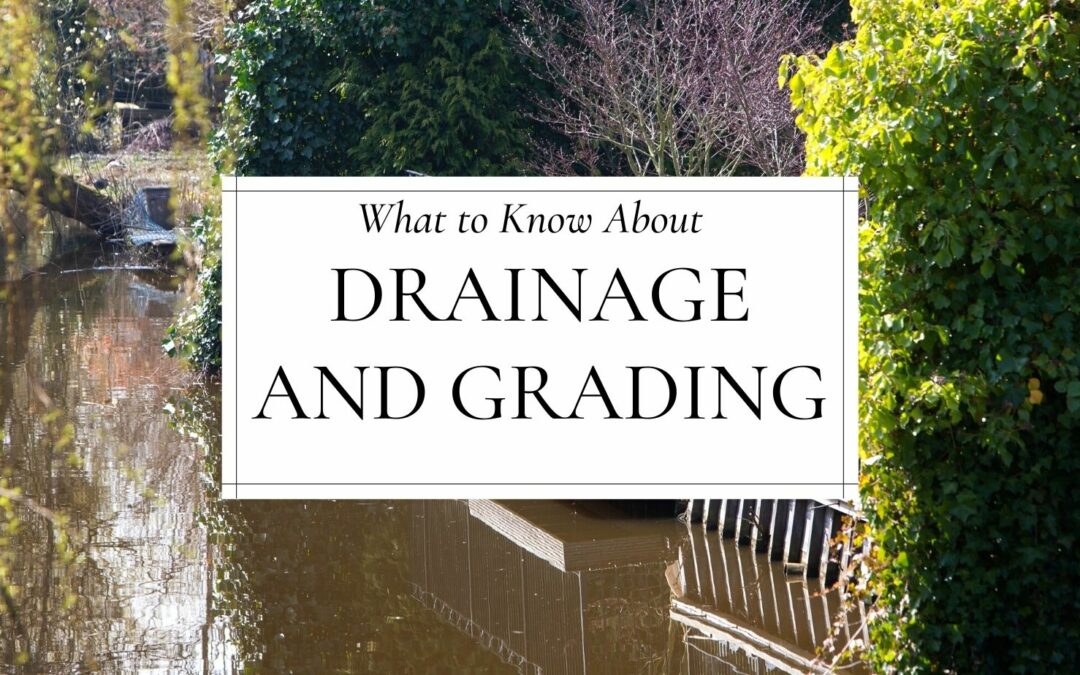What to Know About Drainage and Grading – Before beginning any major landscape design, we must talk about drainage and grading. Proper grading and stormwater management is the first thing to consider in any landscaping project. You want your landscape design to provide long-lasting ambiance, beauty, and functionality and sometimes, what you can’t see can damage the landscaping unless you take care of it ahead of time.
Water damage can wreak havoc not only on your landscape but nearby buildings, trees, patios and your home. Cooling water near the foundation can damage the structure and integrity of your house so keeping that water away from the house and any other buildings is really key to providing long-lasting and semi-maintenance-free landscaping.
What is landscaping grading?
Landscaping grading refers to the scoping or leveling of land intended to prepare outdoor places and spaces for hard skating, pathways, patios, stairs, plants, or just preventing water from pooling when it rains.
When you grade the landscape for water pooling prevention it’s called drainage. Grading and drainage can be defined as the reshaping of your property or land between different points in the landscaping to properly drain the site and steer water away from structures and prevent flooding.
Regardless of your land and surface characteristics, slope is the most important issue to consider. For effective drainage, paved surfaces should have a minimum 1% slope and turf or landscaped areas should have a minimum 2% slope to account for the land soaking up the extra moisture.
Grading is typically measured by the horizontal length of an elevation, the run, and the vertical height of the elevation or the rise. Grade is expressed as rise or run, so if the rise is 25 and the run is 80, the greatest consider 25/80. But, that’s a lot of information you may not need to know if you hire a professional landscaper to take care of drainage and grading.
Additional Drainage and Grading Help
Sometimes, if simple training and graded just with the typography cannot be achieved, homeowners will need to install drainage systems to control the amount of water flow into landscapes, gardens, and away from basements or foundations. French drains can accomplish this by digging down at least 2 feet, burying pipe that carries the water away and then filling it with rocks allowing the water to seep through to the cloth-covered drainpipe and carry the water away from the home.
Drainage and grading is extremely important when it comes to environmental factors such as stormwater runoff. This type of water runoff can erode streams and wash sediment into receiving waters, especially if you live close to a Creek or River. By installing a drainage system, it can infiltrate runoff into the soil and redistribute water into other vegetation or even your lawn.
Surface drainage collects water from the surface of the ground and redirects it elsewhere. This is a drainage system that typically collects rainwater before it has a chance to enter the stormwater systems. Surface drainage and grading require a channel or ditch and reshaping and grading the surface to eliminate pooling for long-term saturation.
Subsurface drainage is installed beneath the soil surface and is used for landscapes, gardens, and usually behind retaining walls that can collect moisture.
How do you know when you have a drainage problem?
The easiest way to tell if you have a drainage problem is if you have areas of pooling water after a storm or major rainfall. If you notice that there is standing water for longer than 24 hours in a particular area, chances are you have a drainage issue. If that water pools too close to the foundation of your house, you could have a major problem on your hands if it’s not corrected sooner.
For more information on drainage and grading or if you have questions on whether or not your home and property needs proper drainage, give us a call for a quote. We’d be happy to come out and discuss your options and how you can preserve your landscaping for years to come.
Additional Garden and Landscape Additions Tips:
The Difference Between Urban Design and Landscape Architecture
The 7 Principles of Landscape Design
10 Great Ways to Improve Your Backyard
Tools and organizing for your shed
5 Easy Landscaping Tips for Rental Properties
7 Tips to Beautify Your Winter Landscape
10 Questions to Ask When Hiring a Landscaper

